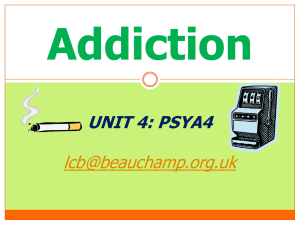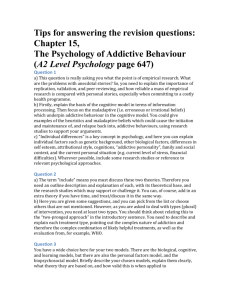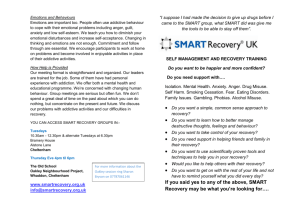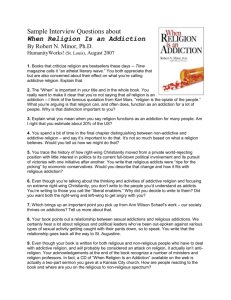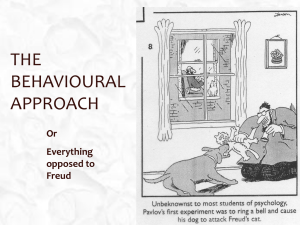Addiction lesson 4 – Learning approach and smoking
advertisement
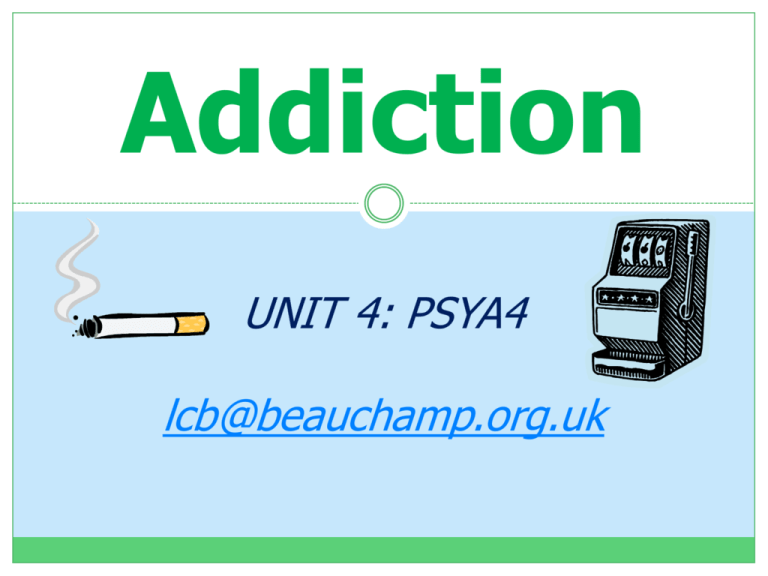
Addiction UNIT 4: PSYA4 lcb@beauchamp.org.uk Content The Psychology of Addictive Behaviour Models of Addictive Behaviour Biological, cognitive and learning approaches to explaining initiation, maintenance and relapse, and their applications to smoking and gambling. Vulnerability to Addiction Risk factors in the development of addiction, including stress, peers, age and personality. Media influences on addictive behaviour. Reducing Addictive Behaviour The theory of planned behaviour as a model for addiction prevention. Types of intervention and their effectiveness, including biological, psychological and public health interventions. Starter Answer the 5 questions in your booklet to review your psychological knowledge of the behaviourist (i.e. learning) model from AS-Level. You have 5 minutes! Basic principles of the learning approach Addictive behaviours are acquired habits which are learned according to the principles of CC, OC and SLT. Addictions can be unlearned. Addictions are not ‘all or nothing’ categories i.e. there are degrees of addictive behaviour. Addictions are no different to any other behaviour. Pair activity Using your psychological knowledge from AS, discuss and make notes in the table in your booklet on… Classical conditioning 2. Operant conditioning 3. SLT 1. Where possible, think how it may link to addictive behaviours. Classical conditioning Learning through association. Linking two things together. Conditioning means learned. Stimulus An event which causes a response e.g. food Response A reaction made because the stimulus has been detected e.g. salivation. Pavlov UCS UCR NS CS CR Who remembers Little Albert? Put the 3 words below next to the correct terms to explain the process of classical conditioning in this example (you will need to use them more than once!) Step 1 UCS = unconditioned stimulus UCR = unconditioned response Step 2 NS = neutral stimulus + Step 3 UCS = unconditioned stimulus CR = conditioned response CS = conditioned stimulus Anxiety UCR = unconditioned response Rat Noise Operant conditioning Learning through reinforcement. Dependent on consequences of actions (e.g. reward). Positive reinforcement – Behaviour = pleasant consequence = behaviour repeated. 2. Negative reinforcement – Behaviour = unpleasant consequence removed = behaviour repeated. 3. Punishment – Behaviour = unpleasant consequence = behaviour not repeated. 1. Social Learning Theory 1. The observation and imitation of influential role models in the environment. 2. Witness reinforcement. 3. Imitate observed behaviour with anticipation of receiving similar reinforcement (vicarious learning). 4. More likely if identify with role model (e.g. same age/gender) or if of high status/position of power and admire them. Independent task 1. Complete the table in your booklet (comparing and contrasting biological and learning models of addiction). 2. Colour-code if the term belongs to the biological approach or the learning approach of addictive behaviour. You have 10 minutes. Be prepared to feedback. What’s next? In today’s lesson we are going to look at how the learning approach explains the initiation, maintenance and relapse of smoking addiction. RECAP: What do these terms mean? 1. Initiation? 2. Maintenance? 3. Relapse? Stages in addiction 1. Initiation – the process whereby an individual starts to become addicted. 2. Maintenance – the process whereby people continue to behave addictively even in the face of negative consequences. 3. Relapse – the process whereby individuals who have managed to give up their addictive habits (i.e. they are in remission) start to show signs and symptoms of the addictive behaviour again. Learning Approach - Smoking Read the information in your booklet on the learning approach to smoking addiction. Summarise the approach for each stage in your booklet or draw into pics. You have 10 minutes! Maintenance of smoking addiction Step 1 UCR = unconditioned response Feel relaxed UCS = unconditioned stimulus Sitting with friends Step 2 NS = neutral stimulus Smoking cigarette + Step 3 CS = conditioned stimulus Smoking cigarette UCS = unconditioned stimulus Sitting with friends UCR = unconditioned response Feel relaxed CR = conditioned response Feel relaxed The individual learned that smoking can provide the same rewards (i.e. feeling relaxed) as the original UCS (i.e. sitting with friends). Research (A02) Complete the gap fill in your booklet and read the information on Cue-Reactivity Theory. You have 10 minutes. Q&A! EVIDENCE – FOR OR AGAINST? 1. Read the three studies in your booklet. 2. Decide if they support or contradict the learning model of smoking addiction. 3. Explain why in the boxes provided! Read the evaluation paragraph and summarise the two main points in the box provided. IDA – A02 Pair discussion Discuss and make notes on the four IDA evaluation points in your booklet. IDA Gender bias in smoking addiction research The onset and development of smoking follows different patterns in men and women. Research found that women start smoking later than men and that there are gender-related differences in relation to the stages and context of smoking. Real-world applications Effective forms of drug prevention programmes should target adolescents (most vulnerable to influence of peers). Resistance training can inform them of the social pressure of smoking and hopefully reduce the risk of addictive behaviour. IDA Nature vs. nurture The learning approach supports nurture (environment), ignores nature - biological approach (i.e. innate, genetics, biochemistry). Determinism vs. free will Deterministic because it suggests smoking addiction is influenced by external factors (environment/learning/social pressure/peers and parents) – however could be argued free will as choose who to look to as role model – SLT. To evaluate learning explanations use other approaches e.g. biological!!!


